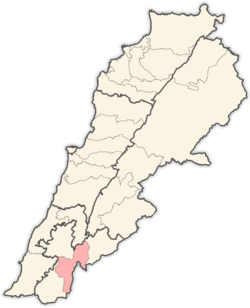Marjayoun
Marjayoun (Arabic مرجعيون, also Marj 'Ayoun, Marjuyun or Marjeyoun - meaning "meadow of springs") is a Lebanese town and administrative district, Marjeyoun District, in the Nabatieh Governorate in Southern Lebanon. It is 860 metres (2,822 ft) above sea level, and it is located on the west side of the Rift Valley Bank just across from the ancient regional capital, Caesarea Philippi, which was located at the foot of Mt. Hermon on the east side of the Rift Valley. It is not to be confused with the Banias Springs at Caesarea Philippi.
Marjeyoun is on a hill facing Mount Hermon to the East, Beaufort Castle, the 1000-year-old Crusader Castle above the Litani River and overlooking Mount Amel (Jabal Amel) to the West, the summits of Rihan and Niha and the rest of the Mount Lebanon range to the North and the fertile plains of Marjeyoun that extend southward into the Galilee plains and the Golan Heights. The historic Cathedral of Saint Peter is in Marjayoun.[citation needed]
History
On June 10, 1179, during the Battle of Marj Ayyun, an Ayyubid army commanded by Saladin defeated a Crusader army led by King Baldwin IV of Jerusalem on June 10, 1179. The Christian king narrowly escaped being captured in the rout.[citation needed]
During the Lebanese civil war the town was shelled by Palestinian militias.[citation needed]
It also was the headquarters of the South Lebanon Army, the Israel-affiliated militia that controlled southern Lebanon during Israel's occupation of the region after the 1982 Lebanon War until Israel's withdrawal from the region in 2000.[1] It has a population of about 3,000 people.
After cease-fire negotiations stalled on August 10, 2006, Israeli forces took control of Marjayoun.[2] The next day, a convoy of 3,000 people fled from the town. The convoy was attacked by the Israeli Air Force (IAF) at Joub Jannine. The attack on the convoy of approximately 759 vehicles containing Lebanese police, army, civilians, and one Associated Press journalist is known as the Marjayoun convoy incident.
Demography
The town of Marjayoun has a mixed population - Greek Orthodox, Maronite and Greek Catholic Christians, as well as Sunni Muslims, Druze and Shia Muslims. Christians form a simple majority of the population now, but losing their primacy in the town as the number of Shia Muslims steadily increase. Despite this demographic decline, Marjayoun still maintains a Christian air. Outside the town, most villages in the surrounding valleys and mountains surrounding are predominantly Shia Muslim.[citation needed]
The district of Marjayoun, which covers a greater area than the town, is largely Shi'a Muslim. It recognizes three seats in the Lebanese government, two belonging to Shi'a Muslims and one belonging to Orthodox Christians.[citation needed]
Hospital
Marjayoun is home to a regional government hospital,[citation needed] and a Lebanese Red Cross First Aid Center.[3]
Notable people
- Walid Gholmieh – director of the Le Conservatoire libanais national supérieur de musique; born in Marjeyoun
- Brigitte Gabriel – journalist, author, and activist; born in Marjeyoun.
References
- ↑ Hirst, David. 1999. South Lebanon: The war that never ends? Journal of Palestine Studies 28(3).
- ↑ CNN.com - Sources: U.S., France agree on peace plan - August 10, 2006
- ↑ "Our Centers - First Aid Centers", Lebanese Red Cross
External links
Photo galleries
| ||||||||||
Coordinates: 33°21′39.94″N 35°35′31.45″E / 33.3610944°N 35.5920694°E
